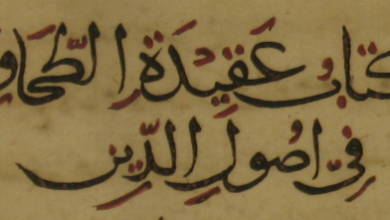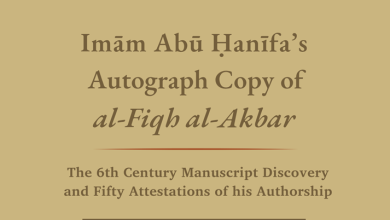Sunni Criticism of Using Weak and Problematic Ḥadīths to Establish Allah’s Attributes in Contemporary Salafi Works
ما الفائدة من تبيين وإخراج الأحاديث الضعيفة والمنكرة والموضوعة في كتب عقائد الحشوية والمجسمة وإظهارها، وقبل ذلك بيان انقطاع أسانيد تلك الكتب إلى مؤلفيها؟
What is the benefit of clarifying, extracting and revealing the weak, rejected and fabricated hadiths in the books of the creeds of the Ḥashwiyya[i] and the anthropomorphists [Mujassima], and before that, explaining the discontinuity of the chains of transmission of those books to their authors?
أولا: يجب أن تعلم أن هذه الكتب والأحاديث التي فيها مقبولة عندهم، ولذلك رووها وتداولوها بينهم، لذلك وجب التنبيه عليها.
First: You should know that these books and the hadiths in them are accepted by them, and that is why they narrated them and circulated them among themselves, so it was necessary to point them out.
فهي عندهم طالما أنها جاءت في هذه الكتب، فهي محتج بها وتقوم عليها عقائدهم، وإلا لما أوردها سلفهم فيها.
For them, as long as they came in these books, they are to be argued with and their creeds are based on them, otherwise their predecessors would not have included them in them.
وخذ على سبيل المثال: روى الدشتي في كتابه إثبات الحد حديثا (25) أين كان ربنا قبل أن يخلق الخلق؟ قال [أي النبي ﷺ]: “على عماء تحته هواء، ثم خلق عرشه على الماء” وفي رواية: “في عماء، ما فوقه هواء وما تحته هواء ثم خلق عرشه على الماء”.
For example: Al-Dashtī narrated in his book Ithbāt al-Ḥadd a hadith (25) “Where was our Lord before He created the creation?” He [i.e. the Prophet ﷺ] said: “On ‘Amā’[ii] with air under it, then He created His Throne on water.” And in another narration: “In ‘Amā’, with no air above it and no air below it, then He created His Throne on water.”
فهذا الحديث ضعيف ولا يصح، فيه وكيع بن حدس وهو مجهول، ولو تأملنا الحديث بالرواية الأولى والثانية ففيها كوارث، الكارثة الأولى: إثبات قديم مع الله وهو الهواء، أو على اعتقادهم يصح أن يستدل به على تسلسل الحوادث في الماضي. الكارثة الثانية: في الرواية الثانية قوله: “ما فوقه هواء”، فيه إثبات فوقية الهواء على الباري عز وجل -تعالى الله- فهو زيادة على المحدودية من الفوق والأسفل هناك شيء يعلوه.
This hadith is weak and not authentic. It contains Wakī’ ibn Ḥidas who is unknown. If we contemplate the hadith with the first and second narrations, there are catastrophes in them. The first catastrophe: Affirming something eternal with Allah which is the air, or according to their belief, it is valid to use it as evidence for the sequence of events in the past. The second catastrophe: In the second narration, his saying “with no air above it”, in it is the affirmation of the air being above the Creator, Glorified and Exalted is He above that, so it is in addition to limitedness from above and below, there is something above Him.
لكن ماذا قال محققا الكتاب؟
قالا: “الحكم على الحديث: احتج أهل العلم بهذا الحديث في مصنفاتهم -كما تقدم في تخريجه- وساقوه مساق القبول والاحتجاج، وممن صرح بصحته أبو عبيد القاسم بن سلام…”. [راجع كتاب الحد للدشتي – الحاشية ص 132 – تقديم وتعليق مسلط العتيبي وعادل آل حمدان]
But what did the two verifiers of the book say?
They said: “The ruling on the hadith: The scholars argued with this hadith in their compilations – as was mentioned previously in its extraction – and they narrated it with acceptance and argument, and among those who explicitly stated its authenticity was Abū ‘Ubayd al-Qāsim ibn Sallām…” [See the book al-Ḥadd by al-Dashtī – footnote p. 132 – presentation and commentary by Musallat al-‘Utaybī and ‘Ādil Āl Ḥamdān]
فنلاحظ هنا أن هؤلاء يحتجون بهذا الحديث رغم ما فيه من نكارة في المتن وضعف في الإسناد، فقط لأن هناك من خرجه !، ثم تخيل أن يكون هذا الفعل في مسائل الاعتقاد وأصول الدين !.
So we notice here that they argue with this hadith despite the oddity in its text and the weakness in its chain of transmission, only because there are those who extracted it! Then imagine this being done in matters of creed and the fundamentals of religion!
فنحن حينما نستخرجها ونظهرها للناس، فقط ليعلموا كيف تقوم عقائد هؤلاء المجسمة الحشوية في ذات الله عز وجل وفي أسمائه وصفاته.
So when we extract them and reveal them to the people, it is only so that they know how the creeds of these anthropomorphist [mujassima] Ḥashwiyya regarding Allah Almighty and His names and attributes are based.
ثانيا: يشاغب بعض الجهال من هنا وهناك وخاصة من الوهابية بطبيعة الحال، بأن هذه الأحكام مأخوذة من كتبهم ومن أحكامهم هم كالألباني وغيره.
Second: Some ignorant people here and there, especially the Wahhabis of course, argue that these rulings are taken from their books and from their own rulings, such as Al-Albānī and others.
نعم.. وهل قلنا غير ذلك؟ فلماذا هذا الغباء؟ نعم الأحكام من كتبهم، وهذه الأحكام على الأحاديث يجب أن تعلم أولا أنها ليست من مكتشفاتهم، فهي أحكام سابقة من الأئمة سواء على الأحاديث أو حتى على رجال الأسانيد، فلم يخترع الوهابية ممن يشتغلون بالحديث شيئا، وجلب الأحكام من كتبهم من باب إقامة الحجة عليهم لا أكثر، فالألباني رحمه الله ومن تأثر به أقل شرا في العقيدة من هؤلاء الغالين في ابن تيمية وابن عبدالوهاب، لأن الألباني ومن تأثر به غالبا هم مطردون في أحكامهم على الحديث، فكما أنهم لا يجاملون في الضعيف في الفضائل والأحكام (جهلا منهم طبعا) فكذلك لا يجاملون فيما يتعلق بالعقائد، ولذلك تجد أن الألباني عند هؤلاء الغالين مرجئ، وكل من يتأثر به فهو من المرجئة.
Yes, did we say otherwise? So why this stupidity? Yes, the rulings are from their books, and these rulings on hadiths, you should know first that they are not from their discoveries. They are previous rulings from the Imams, whether on hadiths or even on the men of the chains of transmission. The Wahhabis who engage in hadith did not invent anything. Bringing the rulings from their books is to establish the proof against them, no more. Al-Albānī, may Allah have mercy on him, and those influenced by him are less evil in creed than these extremists in Ibn Taymiyya and Ibn ‘Abd al-Wahhāb, because Al-Albānī and those influenced by him are usually consistent in their rulings on hadith. Just as they do not compromise on the weak in virtues and rulings (out of their ignorance of course), they also do not compromise with regards to creeds. Therefore, you find that Al-Albānī according to these extremists is a Murji’ite, and everyone who is influenced by him is one of the Murji’a.
ولكن انظر ماذا فعل المحققان هنا مثلا في الحكم على الحديث؟ حكما عليه بالقبول رغم ضعفه ونكارة متنه، وماذا فعل الدشتي قبلهم؟ أثبت صفات وأثبت أشياء منكرة وباطلة في حق الباري عز وجل بهذه الأحاديث الضعيفة، بل عنون كتابه بإثبات الحد لله وأنه قاعد وجالس، وإثبات خرافات ومنكرات كإثبات الأطيط، وهو لا يصح فيه حديث واحد كما يقول الألباني منهم.
But look at what the two verifiers (muḥaqqiqān) did here for example in judging this ḥadīth. They judged it as acceptable despite its weakness and the repugnancy (nakāra) of its content (matn). And what did al-Dashtī do before them? He affirmed attributes and affirmed repugnant (munkara) and false things regarding the Creator (al-Bāri’), Glorified and Exalted is He, using these weak aḥādīth. He even titled his book “Establishing the Boundary (ḥadd) for Allah” and that He sits and is seated. He affirmed myths (khurāfāt) and repugnant things (munkarāt) like affirming the creaking (aṭīṭ) [of the Throne], about which there is not a single authentic ḥadīth, as al-Albānī, who is one of them, says.
وبحسب منطق المحققين فعلينا أن نقبل الخرافات التي جاءت أيضا في كتاب السنة لحرب الكرماني التي فيها أن العرش تحمله حية ضخمة، وفي رواية على قرون الوعول، وأن عرقها تكونت منها المجرات، وغيرها من الترهات والخرافات!، وبحسب منطق المحققين فإن الكرماني احتج بهذه الأحاديث والأخبار وقبلها، وقبلها كل من روى عن الكرماني، أو روى مثلها غيره!.
And according to the logic of the verifiers, we must accept the myths that also came in the book al-Sunna by Ḥarb al-Kirmānī in which there is (a narration) that the Throne is carried by a huge snake, and in a narration on the horns of mountain goats, and that the galaxies were formed from its sweat, and other nonsense and myths! And according to the logic of the verifiers, al-Kirmānī argued with these hadiths and reports and accepted them, and everyone who narrated from al-Kirmānī accepted them, or others narrated similar things!
إذن فهناك عقائد تقوم على هذه الأحاديث الضعيفة والمنكرة والموضوعة.
Therefore, there are creeds that are based on these weak, rejected and fabricated hadiths.
ونعم هناك من هم أقل شرا فيهم في العقائد، وأهل السنة يفرحون بذلك، ويأخذون بأيديهم، فإن بعض الشر أهون من بعض، وأهل السنة مع من يريد الإصلاح ما استطاع، حتى لو كان من المخالف، ولكنه إصلاح يلتقي فيه مع أهل السنة ويخفف من وطأة التجسيم والانحراف العقائدي.
Yes, there are among them those who are less evil in creed, and the Ahl al-Sunna rejoice in that, and take them by their hands, for some evil is less severe than others. The Ahl al-Sunna are with those who want reform as much as possible, even if they are from the opposing side. But it is a reform in which they meet with the Ahl al-Sunna and reduce the impact of anthropomorphism [tajsīm] and doctrinal deviation.
هذا مثال فقط، فأما العاقل ومن قرأ كتبهم فإنه يعرف هذا المنهج عنهم وما نتكلم عنه، وأما الجاهل المركب الذي حظه من العلم قوقل أو التتلمذ على طلاب قوقل واليوتيوب فلسنا ملزمين بإفهامه، فإنه قد قيل:
إلا الحماقة أعيت من يداويها.
This is just an example. As for the intelligent one and the one who has read their books, he knows this approach of theirs and what we are talking about. As for the compound ignorant one whose share of knowledge is Google or being a student of Google and YouTube students, we are not obligated to make him understand, for it has been said:
“Except for stupidity, it has exhausted the one who treats it.”
[i] The Hashwiyya (الحشوية) was a term used by various Islamic theological schools, to refer to an early Islamic sect or group known for their extreme and anthropomorphic views about Allah’s attributes.
Key points about the Hashwiyya:
The name comes from the Arabic root ḥ-sh-w (حشو), which means “to stuff, fill, or pad.” It implies a kind of “stuffing” or “filling” the Divine with creaturely attributes.
They were accused of taking Qur’anic passages and hadiths that describe Allah in human terms (like having a face, hands, sitting on a throne, etc.) in a strictly literal way, without applying any metaphorical interpretation (ta’wil).
Their opponents saw them as anthropomorphists (mujassima) who likened Allah to created beings and compromised divine transcendence (tanzih)
[ii] عماء (‘amā’) is an Arabic term that appears in some narrations and discussions related to Islamic theology and cosmology. Its exact meaning is a matter of interpretation and debate. A few key points:
– It comes from a root meaning “to be blind or concealed.” So it has the connotation of something unclear, hidden or obscure.
– In the context of narrations about Allah’s existence before the creation, like the one mentioned in the previous Arabic passage, it is often taken to mean “nothingness” or “non-existence.” I.e. Allah existed and there was nothing else – no creation, no light, no air, just a state of ‘nothingness.’
– Some scholars have understood it to mean a kind of primordial “cloud” or “dust” from which Allah later fashioned the creation.
– Others have said it shouldn’t be taken literally, but points to the fact that we fundamentally cannot comprehend Allah’s state before the act of creation.
So in summary, it is a theologically significant but ambiguous term, subject to much interpretation, that appears in certain hadiths and kalām (theological) discussions about Allah’s existence and creative act before the bringing into being of the heavens, earth and physical universe as we know it. The manner of interpreting it was a point of contention between different schools of theology.
NB – The Arabic text was posted by an unnamed individual in a Telegram channel. The text was translated by www.darultahqiq.com with the footnotes






